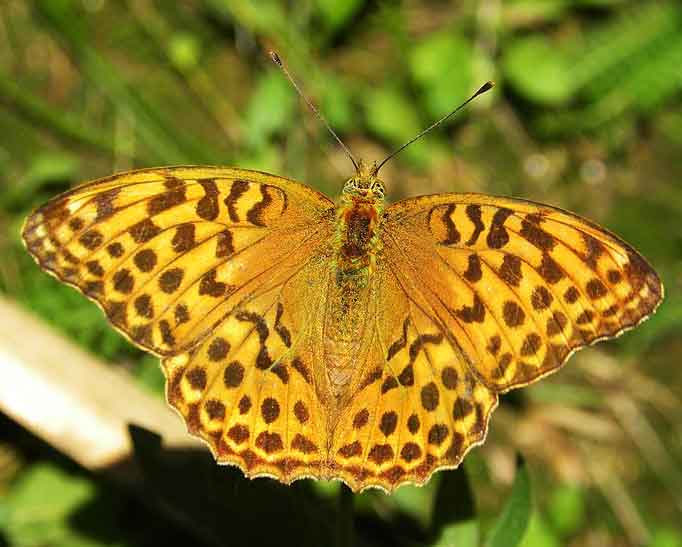
Argynnis paphia (*)
Superregnum: Eukaryota
Cladus: Unikonta
Cladus: Opisthokonta
Cladus: Holozoa
Regnum: Animalia
Subregnum: Eumetazoa
Cladus: Bilateria
Cladus: Nephrozoa
Cladus: Protostomia
Cladus: Ecdysozoa
Cladus: Panarthropoda
Phylum: Arthropoda
Subphylum: Hexapoda
Classis: Insecta
Cladus: Dicondylia
Subclassis: Pterygota
Cladus: Metapterygota
Infraclassis: Neoptera
Cladus: Eumetabola
Cladus: Endopterygota
Superordo: Panorpida
Cladus: Amphiesmenoptera
Ordo: Lepidoptera
Subordo: Glossata
Cladus: Coelolepida
Cladus: Myoglossata
Cladus: Neolepidoptera
Infraordo: Heteroneura
Cladus: Eulepidoptera
Cladus: Ditrysia
Cladus: Apoditrysia
Cladus: Obtectomera
Superfamilia: Papilionoidea
Familia: Nymphalidae
Subfamilia: Heliconiinae
Tribus: Argynnini
Genus: Argynnis
Species: Argynnis paphia
Subspecies: A. p. angustia – A. p. argyrophontes – A. p. argyrorrhytes – A. p. butleri – A. p. delila – A. p. dives – A. p. formosicola – A. p. geisha – A. p. masandarensis – A. p. megalegoria – A. p. neopaphia – A. p. paphia – A. p. pusilla – A. p. thalassata – A. p. tsushimana – A. p. virescens
Name
Argynnis paphia (Linnaeus, 1758)
Synonyms
Basionym: Papilio paphia Linnaeus, 1758
References
Primary references
Linnaeus, C. 1758. Systema Naturae per regna tria naturae, secundum classes, ordines, genera, species, cum characteribus, differentiis, synonymis, locis. Editio Decima, Reformata. Tomus I. Holmiæ (Stockholm): impensis direct. Laurentii Salvii. 824 pp. DOI: 10.5962/bhl.title.542 BHL p. 481 BHL Reference page.
Additional references
Churkin, S.V. & V.A. Pletnev, 2012: A new subspecies of Argynnis paphia (Linnaeus, 1758) from Ferghana (Lepidoptera: Nymphalidae). Atalanta 43 (1-2): 114–117.
Links
http://www.nic.funet.fi
Argynnis paphia Taxon details on Fauna Europaea
ZooBank: 5549C78C-F30C-4DA7-BDE9-20B16A06437B
Vernacular names
беларуская: Перламутраўка вялікая лясная
български: Венерина седефка
català: Argentada comuna
Cymraeg: Britheg arian
dansk: Kejserkåbe
Deutsch: Kaisermantel
English: Silver-washed Fritillary
español: Argynnis paphia
eesti: Rohetäpik
فارسی: فرچهپای نقرهای
suomi: Keisarinviitta
français: Tabac d'Espagne
Frysk: Keizersmantel
magyar: Nagy gyöngyházlepke
日本語: ミドリヒョウモン
lietuvių: Didysis perlinukas
latviešu: Lielais meža raibenis
Nederlands: Keizersmantel
norsk: Keiserkåpe
polski: Perłowiec malinowiec
русский: Перламутровка большая
slovenčina: Perlovec striebristopásavý
slovenščina: Gospica
shqip: Argynnis paphia
svenska: Silverstreckad pärlemorfjäril
中文: 綠豹斑蝶
The silver-washed fritillary (Argynnis paphia) is a common and variable butterfly found over much of the Palearctic realm – Algeria, Europe, temperate Asia, and Japan.
Description
The silver-washed fritillary butterfly is deep orange with black spots on the upperside of its wings, and has a wingspan of 54–70 mm, with the male being smaller and paler than the female. The underside is green, and, unlike other fritillaries, has silver streaks instead of silver spots, hence the name silver-washed. The caterpillar is black brown with two yellow lines along its back and long reddish-brown spines.
The male possesses scent scales on the upperside of the forewing that run along veins one to four. The scent produced from these scales attracts females and helps to distinguish it from other species.
Food resources
Adults feed on the nectar of bramble, thistles, and knapweeds, and also on aphid honeydew. The silver-washed is a strong flier, and more mobile than other fritillaries, and, as such, can be seen gliding above the tree canopy at high speed. Its preferred habitat is thin, sunny, deciduous woodland, especially oaks, but it has been known to live in coniferous woodland.
The main larval food plant of the species is the common dog violet (Viola riviniana).[1]
Figs 1,1a,1b,1c,1d larva after last moult 1e pupa
Life cycle
Unusually for a butterfly, the female does not lay her eggs on the leaves or stem of the caterpillar's food source (in this case violets), but instead one or two meters above the woodland floor in the crevices of tree bark close to clumps of violets.
When the egg hatches in August, the caterpillar immediately goes into hibernation until spring. Upon awakening, it will drop to the ground, and feeds on violets close to the base of the tree. The caterpillar usually feeds at night, and usually conceals itself during the day away from its food source, but during cool weather will bask in the sunny spots on the forest floor on dry, dead leaves. It will pupate amongst the ground vegetation, and the adults will emerge in June.
Subspecies
Argynnis paphia butleri Krulikovsky, 1909 northern Europe, central Europe
Argynnis paphia thalassata Fruhstorfer, 1909 southern Europe
Argynnis paphia dives (Oberthür, 1908) Algeria
Argynnis paphia argyrorrhytes Seitz, [1909] North Caucasus
Argynnis paphia delila Röber, 1896 Turkey
Argynnis paphia masandarensis Gross & Ebert, 1975 Iran
Argynnis paphia pusilla Wnukowsky, 1927 north-west Siberia
Argynnis paphia neopaphia Fruhstorfer, 1907 Amur
Argynnis paphia virescens Nakahara, 1926 Kuriles
Argynnis paphia geisha Hemming, 1934 Japan
Argynnis paphia tsushimana Fruhstorfer, 1906 Japan
Argynnis paphia megalegoria Fruhstorfer, 1907 Szechuan, Yunnan
Argynnis paphia argyrophontes Oberthür, 1923 south-west China
Argynnis paphia formosicola Matsumura
Conservation
The silver-washed fritillary was in decline in the UK for much of the 1970s and 1980s, but seems to be coming back to many of its old territories.
References
Source
Tom Tolman and Richard Lewington, 2009 Collins Butterfly Guide:The Most Complete Field Guide to the Butterflies of Britain and Europe Harper Collins. ISBN 978-0-00-727977-7.
Crory, Andrew. 2016. Fritillary Butterflies. The Irish Hare. Ulster Wildlife Membership Magazine. Issue 113 p. 4
Notes
"Silver-washed Fritillary". UK Butterflies. Retrieved 20 June 2011.
Retrieved from "http://en.wikipedia.org/"
All text is available under the terms of the GNU Free Documentation License

